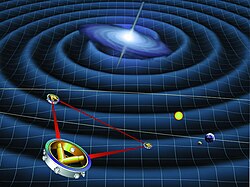Laser Interferometer Space Antenna

Laser Interferometer Space Antenna (LISA), v dřívější menší verzi označovaný jako Evolved Laser Interferometer Space Antenna (zkratka eLISA), je plánovaný projekt Evropské kosmické agentury ESA určený k detekci a přesnému měření gravitačních vln.
Systém by se měl skládat ze tří družic a pracovat na principu porovnávání dvou odražených laserových paprsků v interferometru. K vypuštění družic by podle plánů z roku 2024 mělo dojít v roce 2035.[1]
Projekt
Systém by se měl skládat ze tří družic obíhajících kolem Slunce. Jejich vzájemná vzdálenost by měla činit asi 2,5 milionu kilometrů,[2] v dřívějším návrhu eLISA se jednalo o milion kilometrů.[3] Systém by měl fungovat tak, že každá družice vyšle identický laserový paprsek k ostatním družicím, ty jej odrazí zpět a došlé paprsky se porovnají v interferometru. Princip je velmi podobný měření v už existujících pozemských zařízeních LIGO a VIRGO – pokud systémem projde gravitační vlna, vzájemná vzdálenosti družic se nepatrně změní. Tato změna se pak projeví při porovnání obou paprsků v interferometru.[1]
Historie a stav projektu
Projekt LISA byl původně společným ESA a americké NASA.[4] V roce 2012 však NASA z finančních důvodů od projektu odstoupila a ESA pokračuje v projektu sama.
V prosinci 2015 vypustila družici LISA Pathfinder,[5] která měla sloužit k ověření některých principů projektu eLISA.[6] Nesla interferometr a dvě 46 mm velké krychle ze slitiny zlata a palladia, u nichž byla pozorovat jejich vzájemná vzdálenost.
Podle představ z roku 2013 se má do roku 2020 vyvíjet technologie potřebná pro projekt a od roku 2024 se má začít s výrobou komponent a družice.[7]
V lednu 2024 ESA projekt schválila s předpokládaným rozpočtem 1,75 miliardy eur. Start by měl proběhnout v roce 2035.[2]
Na vývoji zařízení pro přepínání hlavního a záložního laseru se podílejí čtyři české vědecké ústavy.[2]
Reference
- ↑ a b ZELENKA, Ondřej. LISA: okno do raného vesmíru. Vesmír. 2025-02-03, roč. 104, čís. 2, s. 124-126. Dostupné online.
- ↑ a b c VRTIŠKA, Ondřej. Projekt LISA s českou účastí dostal od ESA zelenou. Vesmír. 2024-03, roč. 103, čís. 3, s. 130.
- ↑ eLISA [online]. Max Planck Institute for Gravitational Physics (Albert Einstein Institute), 2016 [cit. 2016-02-13]. Dostupné online.
- ↑ LISA Project Office [online]. NASA, 2015-12 [cit. 2016-02-13]. Dostupné online.
- ↑ LISA Pathfinder en route to gravitational wave demonstration [online]. ESA, 2015-12-03 [cit. 2016-02-13]. Dostupné online.
- ↑ LISA Pathfinder [online]. ESA, 2016 [cit. 2016-02-13]. Dostupné online.
- ↑ Selected: The Gravitational Universe - ESA decided on next Large Mission Concepts [online]. Max Planck Institute for Gravitational Physics (Albert Einstein Institute), 2016 [cit. 2016-02-13]. Dostupné v archivu pořízeném dne 2013-12-03.
Související články
Externí odkazy
 Obrázky, zvuky či videa k tématu Evolved Laser Interferometer Space Antenna na Wikimedia Commons
Obrázky, zvuky či videa k tématu Evolved Laser Interferometer Space Antenna na Wikimedia Commons
Média použitá na této stránce
NASA illustration of LISA, taken from http://lisa.jpl.nasa.gov/gallery/lisa-waves.html. High resolution TIFF compressed with "cjpeg" from libjpeg-progs.
NASA's description:
The three LISA spacecraft will be placed in orbits that form a triangular formation with center 20° behind the Earth and side length 5 million km. (The figure showing the formation is not to scale.)
Each spacecraft will be in an individual Earth-like orbit around the Sun. The orbits are chosen to minimize changes in the lengths of the sides of the triangle. The orbits of the three spacecraft have a relationship between inclination and eccentricity that inclines the plane of the formation by 60° with respect to the ecliptic. The nodal longitudes of the three orbits are shifted by 120° to create the triangle. The heliocentric orbit offers a particularly quiet environment, critical for the control of disturbances on the test masses defining the interferometer arms. The test masses are free-falling and shielded by the enclosing spacecraft from disturbances of the solar wind and photon pressure. The orientation of the spacecraft with respect to the Sun changes very slowly. The Sun appears moves along a cone with a 30° half angle aligned with the spacecraft's cylindrical axis once per year, giving constant illumination. The major source of disturbance in the measurement band is the variation in the solar constant caused by the Sun's normal modes of oscillation, amounting to less than 10 ppm in intensity.
The orbital motion of the antenna sweeps its sensitivity lobes across the sky, giving an amplitude modulation dependent on a source's angular coordinates. Similarly, the Doppler effect gives a phase modulation dependent on a source's angular coordinates. The two effects combine to give directional information about every source. Most of the sources observable by LISA are periodic or quasi-periodic and can be observed for at least a year. The angular position accuracy depends on the signal-to-noise ratio. For the strongest sources, the direction to the source can be determined to about 1 arc minute.